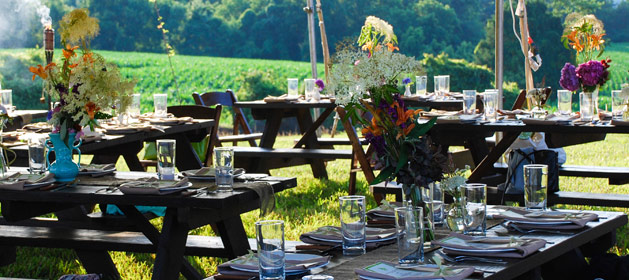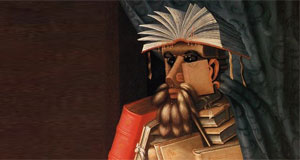Plan an Event
Students will plan for an event, including food, theme, and decorations, and create a proposal demonstrating how the event might look and how much it would cost for various numbers of attendees.
Apps: Wixie®

Task
Everybody loves a party! Well, everyone except maybe the person who has to pay for it. People hold events all the time for a variety of reasons. Businesses host events to introduce clients to new ideas or to say thank you for being a customer. Families hold events to celebrate important dates like birthdays, anniversaries, and marriages.
In this project, you will choose an event or party you would like to plan for your school. For example, you could plan a thank you dinner for volunteers, a celebration for your school’s teacher of the year, or a party for your class or grade. Once you choose an event, you will write a proposal that describes the theme, decorations, and food and calculate how much the party will cost for various numbers of attendees.
Before You Begin
This project engages students in a variety of activities requiring them to apply mathematics. This project isn’t just about budgeting. Students will perform basic computation as they research cost of goods, practice measurement as they look at room setup and layout, and work with ratios as they calculate costs for various numbers of people and the costs for supplies.
Depending on your goals, you may want to structure the project instead of leaving it open-ended. You could establish a budget, choose 3 numbers of participants for ratio purposes, and even direct students to specific vendors for food.
To save time on research, bring in sample menus and invitations. Locate and set parameters for web sites and locations where students can find and price out party supplies and catering. Most chain party supply stores, like Party City, have web sites. Other vendors, like Shindigz, only exist online. If you have a BYOD policy, students can research using their phones and tablets.
While students can keep track of numbers and costs on paper, this project is an excellent opportunity to demonstrate the value of a spreadsheet as a tool for tracking and analyzing data. While they should be demonstrating on paper how they solved ratios using addition and multiplication, tape diagrams, and/or coordinate plans, you may also want to encourage students who have mastered these skills to apply them to design formulas in the spreadsheet to update calculations automatically when values change.
The final proposal should be shared as an oral presentation, supported by charts, graphs, documents, and plenty of writing that both informs and persuades, using the cost analysis to achieve a goal or benefit.
Engage
To introduce the project to students, ask them about an event they attended that was fun and exciting. What was the theme? Was their music, dancing, good food, friends, new people, and/or colorful decorations?
Ask them how the goods they listed are appropriate for different kinds of events, like an awards ceremony or cultural celebration. Help guide them to the idea that a successful event has a goal and that a skilled planner minds the budget while paying attention to the needs and desires of the audience.
Let students know they will be planning an event to be held at their school. (Planning to hold the event at school eliminates the need to rent tables and chairs, helping simplify the process to focus on money and ratios.)

Divide students into teams of 3-5 members. Have them choose an event they would like to plan, such as:
- a fundraiser for a music, sports, or academic club;
- a thank you dinner for volunteers;
- a celebration for your school’s teacher of the year; or
- a cultural celebration.
Create
Once student teams choose an event, they will be responsible for developing a proposal that explains the goal of the event and describes what will happen. Proposals should include specific information about:
- Location(s) and layout(s)
- Time of event and duration
- Menu, including drinks and paper products
- Decorations
- Entertainment
- Invitations and/or advertising
The proposal should include the cost of the event for at least three different group sizes, such as 25, 75, and 150 attendees.
You can choose the numbers of participants or have teams choose their own levels based on their particular event. If students plan a cultural celebration designed for one class, suggest that they also determine the cost to hold the event for multiple classes. If they plan a fundraiser, remind students that a larger group increases the cost, but also increases the potential for revenue.
When considering food options, students should create and show a ratio of selected menu items to the people attending to help make sure there is enough food. Do they have a plan for those who take more than their share?
The oral presentation of the proposal should include multiple forms of media, including text, voice narration, and images. The presentation is a perfect opportunity to utilize multimedia tools like Wixie and Share. Both Wixie and Share include event planning templates.
As students learn to make effective proposals and persuasive pitches, encourage them to include pages or slides about:- Event title and goal
- Theme and how it addresses the goal
- Entertainment
- Food
- Diagrams of layout/room arrangements
- Invitations and advertising
- Total cost
- Cost and budget breakdowns for different numbers of people
Pages or slides should contain text that is both informative and persuasive. Each page should contain images that also serve to inform and persuade. Images, colors, and background music are great ways to set tone and mood.
Since the presentation is meant to be live, students should work to ensure that the text they create for the presentation is concise. They may also want to write out a sample script to support their oral explanations and arguments. Practicing the presentation before giving it is a great way to identify missing information, encourage editing, and make iterative adjustments essential to the design and planning process.
Share
Teams should present their proposals as an oral presentation, supported by charts, graphs, and other documents. Presentations and proposals should include expository writing and speaking that informs as well as persuasive writing and speaking that seeks to have their proposal funded.
Have students present their proposals to your school’s principal, department chairs, Parent Teacher Association, or school board. Ask these stakeholders to help you evaluate the effectiveness of the idea, presentation, and proposal and share their feelings about the level at which they would fund the event.
You may want to speak with your principal or PTA to see if they would be willing to designate a certain amount of money to fund an event before you begin the project. You can use this as the way to establish a budget. This adds an element of competition, so make sure this is consistent with your goals for the project.
Assessment
This project lends itself to assessments in different areas. For math, you can evaluate accuracy of research data and measurement as well as proper application of ratios to determine cost for different numbers of participants. Require students to submit their tape designs or additional tables to demonstrate their understanding of this part of the process. This is a great opportunity for a project check-in.
The proposal project file should provide examples of both informative and persuasive writing. You can also evaluate students’ writing for their ability to develop and communicate with images and diagrams.
The presentation provides an opportunity to assess speaking and oral presentation skills. You may also want to consider evaluating the project management, teamwork, planning, and organization that occurred during the process.
Resources
Judy Allen. Event Planning: The Ultimate Guide to Successful Meetings, Corporate Events, Fundraising Galas, Conferences, Conventions, Incentives and Other Special Events. ISBN: 0471644129
wikiHow: Plan an Event https://www.wikihow.com/Plan-a-Super-Event
Standards
Common Core State Standards English Language Arts - Grade 6
Writing
Text Types and Purpose
2. Write informative/explanatory texts to examine a topic and convey ideas, concepts, and information through the selection, organization, and analysis of relevant content.
2a. Introduce a topic; organize ideas, concepts, and information, using strategies such as definition, classification, comparison/contrast, and cause/effect; include formatting (e.g., headings), graphics (e.g., charts, tables), and multimedia when useful to aiding comprehension.
Production and Distribution of Writing:
4. Produce clear and coherent writing in which the development, organization, and style are appropriate to task, purpose, and audience. (Grade-specific expectations for writing types are defined in standards 1-3 above.)
6. Use technology, including the Internet, to produce and publish writing as well as to interact and collaborate with others; demonstrate sufficient command of keyboarding skills to type a minimum of three pages in a single sitting.
Common Core State Standards Mathematics - Grade 6
Ratios & Proportional Relationships
Understand ratio concepts and use ratio reasoning to solve problems.
3. Use ratio and rate reasoning to solve real-world and mathematical problems, e.g., by reasoning about tables of equivalent ratios, tape diagrams, double number line diagrams, or equations.
Statistics & Probability
5. Summarize numerical data sets in relation to their context, such as by:
5b. Describing the nature of the attribute under investigation, including how it was measured and its units of measurement.
5c. Giving quantitative measures of center (median and/or mean) and variability (interquartile range and/or mean absolute deviation), as well as describing any overall pattern and any striking deviations from the overall pattern with reference to the context in which the data were gathered.
ISTE NETS for Students 2016:
3. Knowledge Constructor
Students critically curate a variety of resources using digital tools to construct knowledge, produce creative artifacts and make meaningful learning experiences for themselves and others. Students:
a. plan and employ effective research strategies to locate information and other resources for their intellectual or creative pursuits.
b. evaluate the accuracy, perspective, credibility and relevance of information, media, data or other resources.
c. curate information from digital resources using a variety of tools and methods to create collections of artifacts that demonstrate meaningful connections or conclusions.
d. build knowledge by actively exploring real-world issues and problems, developing ideas and theories and pursuing answers and solutions.
6. Creative Communicator
Students communicate clearly and express themselves creatively for a variety of purposes using the platforms, tools, styles, formats and digital media appropriate to their goals. Students:
a. choose the appropriate platforms and tools for meeting the desired objectives of their creation or communication.
b. create original works or responsibly repurpose or remix digital resources into new creations.
c. communicate complex ideas clearly and effectively by creating or using a variety of digital objects such as visualizations, models or simulations.
d. publish or present content that customizes the message and medium for their intended audiences.









